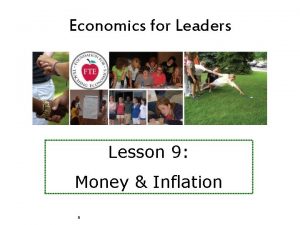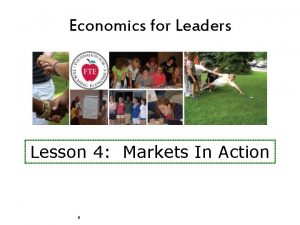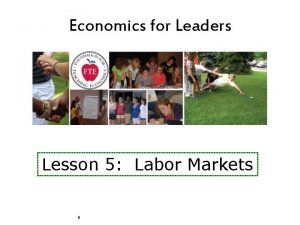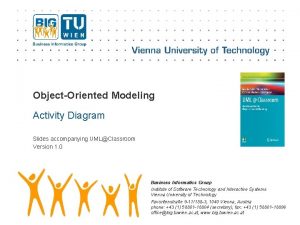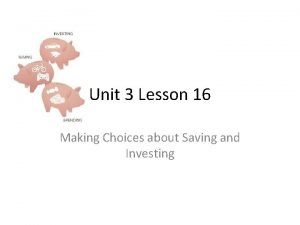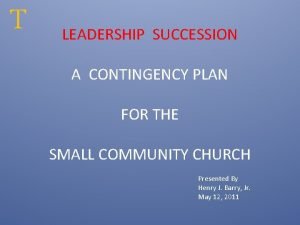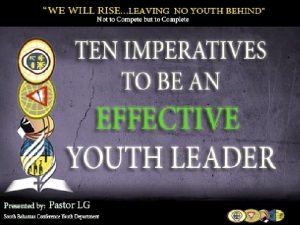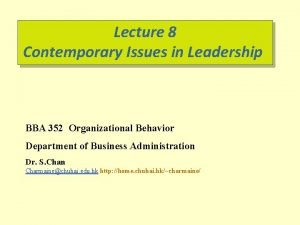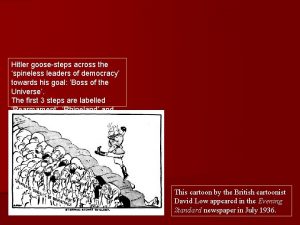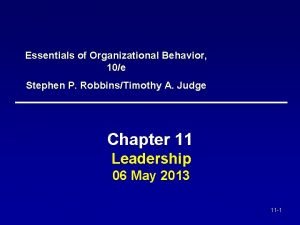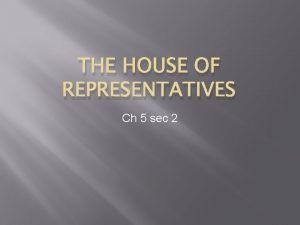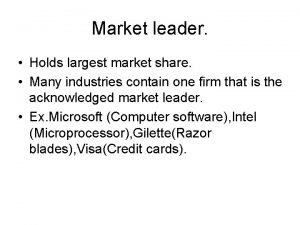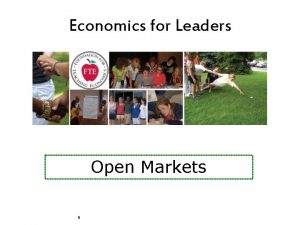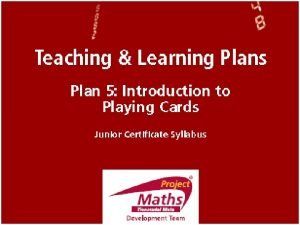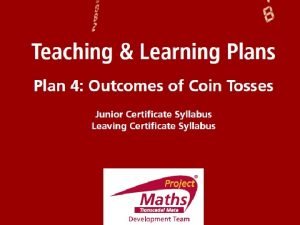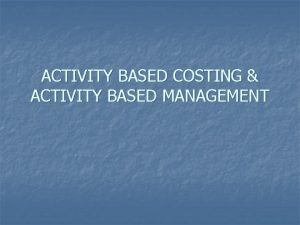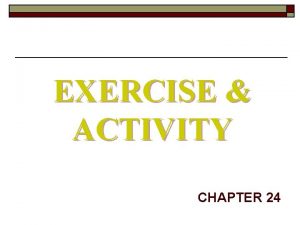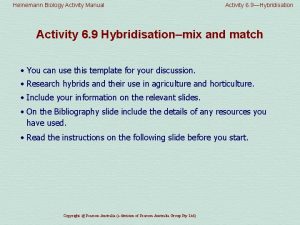Economics for Leaders Activity Slides Economics for Leaders




































































































































- Slides: 132

Economics for Leaders Activity Slides

Economics for Leaders Activity: Magic of Markets

5 Economic Reasoning Propositions 1. People Choose, and individual choices are the source of social outcomes. 2. Choices impose costs; people receive benefits and incur costs when they make decisions 3. People respond to incentives in predictable ways.

5 Economic Reasoning Propositions 4. Institutions are the “Rules of the Game” that influence choices 5. Understanding based on knowledge and evidence imparts value to opinions.

Institutions that foster growth and Economic Development: Open Markets Property Rights Rule of Law Entrepreneurship and Innovation

Why do people trade?

Round 1

Round 2

Why do people trade?

Was it possible to trade without bearing a cost?

What are the necessary conditions for wealth creating to take place? Think INSTITUTIONS! “Rules of the Game” Property Rights Voluntary Exchange

Does the creation of wealth make EVERYONE happy?

Assessment: If we were to observe twenty people buying items at an outdoor Farmers market, what could we conclude about their gains and losses? What could we conclude about their wealth?

Economics for Leaders Activity: The Ultimatum Game

Proposal Selection Form Xy. Zp. DQ Proposer Identification Code _________ Circle a proposal: 9/1 8/2 7/3 6/4 5/5 4/6 3/7 2/8 1/9 If the responder accepts this proposal, $$$$$ I will receive ____ and the responder will receive ____ If the responder does not accept this proposal, both the responder and I will receive $0.

Xy. Zp. DQ If the responder accepts this proposal, I will receive ____ and the responder will receive ____ $$$$$ If the responder does not accept this proposal, both the responder and I will receive $0. Responder Identification Code _________ 123 LMNO If I accept the proposal circled above, $$$$$ and the proposer will receive ____ $$$$$ I will receive ____ If I reject this proposal , I will receive $0 and the proposer will receive $0. Circle either accept or reject below. ACCEPT REJECT

Debrief What did the proposers offer? Why? How did they decide how much to offer?

Debrief Which offers did responders accept or reject? Why? How did responders decide whether to accept or reject an offer?

Debrief A fundamental assumption of economics is that economic man is a rational decision-maker who acts in his self-interest. Are the results of this activity consistent with this theory of homo economicus (economic man)? Why or Why not?

The Ultimatum Game

History • John Nash – 1994 Nobel Prize in Economics for his work in game theory • Game Theory – the study of interactions in which the results of one person’s choices depend not only on his own behavior, but also on the choices made by another person. • Vernon Smith – 2002 Nobel Prize in Economics for experimental economics, which builds on game theory.

“These experiments create an empirical challenge to what we call the selfishness axiom— the assumption that individuals seek to maximize their own material gains in these interactions and expect others to do the same. ” ~Joseph Henrich, Emory University – Completed a 4 -continent research project in which the Ultimatum Game was played in 15 indigenous societies.

Debrief If individuals “seek to maximize their own material gains, ” and assume that other people do, too, what will proposers do? Why? (explain their thinking)

Debrief If individuals “seek to maximize their own material gains, ” and assume that other people do, too, how will responders react to proposals? Why?

Results of Large Numbers of Ultimatum Game Experiments*: the modal (most common) split is 50% - 50% the mean (average) split is about 60% - 40% about 20% of low offers are rejected *Games conducted with college students in the U. S. and other developed countries. Students were paid to participate. Stake was the equivalent of $10 U. S. Results are considered to be “robust. ”

Debrief The results of ultimatum games are inconsistent with the model of economic man that predicts material self-interest (selfishness). Note, especially, the rejection rate.

Proposed Explanations “Other-regarding” Behavior • We gain satisfaction not only from our lives (as the homo economicus model predicts), but also from the lives of others.

Proposed Explanations Reciprocity? Vernon Smith’s variations on the Ultimatum Game suggest that reciprocity motivates people. • Centipede Game: reward the other person for not being selfish, hoping for reciprocal generosity on their turn.

Proposed Explanations More equal splits may be less the result of fearing punishment for being unfair than they are the result of individuals’ concern for their reputations • This is consistent with the results of experiments comparing the behavior of people in market and non-market economies (also consistent with Adam Smith’s observations)

“A dealer is afraid of losing his character, and is scrupulous in observing every engagement. When a person makes perhaps 20 contracts in a day, he cannot gain so much by endeavoring to impose on his neighbors, as the very appearance of a cheat would make him lose. ” ~Adam Smith – Wealth of Nations

“Markets require that even those persons who are not particularly other-regarding in their personal lives become so in their market behavior. Since market exchanges are voluntary, and since the objects the purchaser might acquire are many, entry into the market obliges sellers to become to an important degree other-regarding. ” ~Michael Novak – Business as a Calling

Proposed Explanations Adam Smith’s “Impartial Spectator” We view our behavior through the eyes of an impartial spectator. - Theory of Moral Sentiments

Proposed Explanations Players demand fairness, and punish unfair behavior on the part of proposers. • Vernon Smith’s new “trust game” research supports this hypothesis. Hurtful actions (injustice) merit punishment, while justice (want of injustice) merits no reward. Variations of the Ultimaturm Game • Earned right to be the proposer • Dictator Game • Presented as “transaction” rather than “ultimatum” If innate sense of fairness is the motivator, why are offers different? So perhaps not innate fairness but “functional” fairness.

Conclusions Based on Continued Research Behavior in none of the 15 less-developed societies was consistent with the selfishness axiom. Size of the Stake matters – very high stakes yield lower offers and lower rejection rates. Individual differences do not explain ultimatum game outcomes • age • gender • socio-economic status • risk-aversiveness However. . .

Conclusions based on continued research: Group Differences Matter • in the routine degree of economic cooperation in everyday life (EX: Whaling Communities) And… • in the degree to which markets are an integral part of society Group differences are significant in explaining experimental outcomes

Thus, we return to INSTITUTIONS PERHAPS…. The way people play the ultimatum game reflects the way they interact in everyday life. • Splits are more equal in cultures where people commonly exchange products and labor in markets. • Markets are institutions through which societies develop distinctive patterns of interaction, which may be internalized and reflected in ultimatum game behavior.

Food for Thought (or assessment…) Suppose that someone argued that capitalism is not good for the poor because it makes people greedy and selfish and encourages them to ignore others and think only of themselves. How could you use the results of ultimatum game experiments to counter that argument?

Our Results…

Economics for Leaders Activity: In the Chips

How to Play “In the Chips” Your Goal: Make as much profit as you can over the course of the game.

How to Play “In the Chips”: BUYERS Buyers: Each buyer will have only one buyer card at a time. It will say, “You are authorized to buy a box of computer chips. Pay as little as possible. If you pay more than ______ per box, you lose money. ” To make a “profit, ” buy at a lower price than the price shown on your card. If you buy at a higher price, you suffer a loss. Record the buyer card price & transaction price on your student score sheet.

How to Play “In the Chips”: SELLERS Sellers: Each seller will have only one seller card at a time. It will say, “You are authorized to sell one box of computer chips for as much as possible. If you accept less than ______ per box you lose money. ” To make profit, sell at a higher price than the price shown on your card. If you sell at a lower price, you suffer a loss. Record the seller card price & transaction price on your student score sheet. REPORT TRANSACTION PRICE TO TEACHER

How to Play “In the Chips”: EVERYONE When I say “GO, ” sellers and buyers are free to move around the room and to make transactions with one another. Any seller may talk with any buyer. Both buyers and sellers are free to make as many transactions as they want in a round Remember to trade in your card after each transaction. During the game, keep track of your progress on the student score sheet. In between rounds, compute your gains and losses by taking the difference between the price on your buyer or seller card and the price of the transaction.

Let’s Play!

Debriefing Who made money? Who made the most money? –Strategies? Who lost money? –Why?

Debriefing What conditions made the market work well? –Equal number of buyers and sellers –like products for sale –equal or full knowledge about the products –clear rules concerning what you could/could not do in market

Debrief What can you tell me about price in the various rounds? In which round was there the greatest spread in transaction prices? Why did the transaction prices become more concentrated in the final rounds?

Debrief Who determined the “market price” for computer chips? Buyers? Where would they have set the price if they'd had the power to do so? Sellers? Where would they have set the price if they'd had the power to do so? Would you describe this as a competitive market? Who was in competition with whom?

Debrief How does opportunity cost explain a high price on a seller card? A low price on a buyer card?

Economics for Leaders Activity: Market for Thingamajigs

How to Play - BUYERS Goal: PROFIT Each buyer will have only one buyer card at a time. The card will allow you to buy ONE thingamajig and will tell you how much you value it. To make a “profit, ” buy at a lower price than the price shown on your card. If you buy at a higher price, you suffer a loss. Record the buyer card price on your student score sheet. When the round starts, try to buy below your buyer-card price – the lower, the better. (You may buy at a price higher than that on your buyer card, but note that this will reduce your “profit” for the round. )

How to Play - SELLERS Goal: PROFIT At the beginning of each round, each seller will be given an inventory of 10 Thingamajigs and a role card with the cost per thingamajig. To make profit, sell at a higher price than the cost. If you sell at a lower price, you suffer a loss. Record the transaction prices as you sell on your seller score sheet. In between rounds calculate your profits.

How to Play - EVERYONE All stores are open to all buyers. When a buyer and seller agree on a price, they record the transaction on their transaction records, and the seller gives the Thingamajig to the buyer. The BUYER must then report the transaction by turning in the Thingamajig card to the person keeping the Market Tally in the front of the room. The buyer may then exchange his buyer card for another and try to make another purchase.

How to Play - EVERYONE When the teacher says “Start, ” sellers and buyers are free to move around the room and to make transactions with one another. Any seller may talk with any buyer. Both buyers and sellers are free to make as many transactions as they want in a round. Buyers, remember to turn in your Thingamajig card to the tally keeper and get a new buyer card after each transaction. During the game, keep track of your progress on the student score sheet. Compute your gains and losses by taking the difference between the price on your buyer or seller card and the price of the transaction.

Let’s Play! ROUND 1

Let’s Play! ROUND 1 ROUND 2 ROUND 3 ROUND 4

Transaction Tally

Economics for Leaders Activity: Job Jungle, Copyright 1988 - Raymond P. H. Fishe, all rights reserved.

1 Kitchen - How Many Cooks? # cooks #pizzas made # additional pizzas from hiring this cook? What happened? 0 0 0 1 10 10 Good cook – does everything himself 2 15 1 baker, 1 prep and waiter 3 25 45 4 55 20 10 5 55 0 6 40 -15 No Cook – No Pizza ! 1 baker+1 prep+1 waiter – what a system! Extra guy – helps who ever is behind Things aren’t so hectic Get her out of the way ! Would you hire 6 cooks? What's the most you'd be willing to pay cook #4?

Two Types of Jobs Unskilled or low-skill jobs Skilled Jobs Taking orders Cutting Patterns Sewing Printing Labeling Packing Delivery Bookkeeping Marketing Design Advertising Shipping & Ordering

JOB JUNGLE: Output, Marginal Product, and Marginal Revenue Price of Kites (P) = $_____ $10 Pink Card Workers YELLOW CARD WORKERS (unskilled) # Hired Kites Made Added Product (MP) 1 st 5 5 2 nd 8 3 rd (skilled) # Hired Kites Made Added Product (MP) $50 1 st 8 8 $80 3 $30 2 nd 14 6 $60 10 2 $20 3 rd 19 5 $50 4 th 11 1 $10 4 th 22 3 $30 5 th 12 1 $10 5 th 24 2 $20 6 th 12 0 $0 6 th 25 1 $10 P x. MP P x MP

If You Are a Worker. . . Your goal is to make an income – the more the better! (You'll use this income to purchase the goods and services you want and need. The more income you have, the higher your standard of living. ) The worker with the most income at the end of the game wins a prize. A worker earns income by finding an employer who will hire her at a mutually acceptable wage. All workers start with some money – as indicated on the top of the card. Workers start with different amounts of money because that's the way things are.

If You Are a Worker. . . All workers begin with YELLOW cards and are unskilled. You may not negotiate for a PINK card job when you have a yellow card. A job lasts for only one round. At the beginning of each round, you are unemployed. The wage is for the round and you may only be hired once each round.

If You Are a Worker. . . If you agree to be hired by an employer, have the employer enter the wage on your card and initial it. Once you make a deal, you may not back out or look for a better offer. After you get a job, return to your seat and total your income.

If You Are a Worker. . . At the end of a round, you may buy an education from the teacher for $25. To buy an education, you must have $25 on your yellow card. No loans allowed. The teacher will take your YELLOW card, subtract $25, and enter any remaining $ on a PINK card. When you have a PINK card, you may try to get high skilled jobs.

If You Are an Employer. . . The employer's goal is to make profit – the more, the better! To make profit, you have to produce KITES. To do that, you have to hire workers: You hire low-skilled (YELLOW card) workers to act as cutters, sewers, and printers. You hire high-skilled (PINK card) workers as designers, marketing specialists, accountants, etc.

If You Are an Employer. . . Refer to the "Output" charts in making your hiring decisions. Not all workers are of the same value to you. The output scales are independent. If you hire 2 YELLOW card workers and then hire a PINK card worker, the PINK card worker's wage goes on the "1 st" line of the PINK card worker chart.

If You Are an Employer. . . The wage is for one round only. At the beginning of each round, you start over hiring workers. When you hire a worker, write the wage on his card with your colored pen and initial it. You may not back out on a deal to hire a worker once you've made an agreement. Also record the hire in the “wage paid” column of your profit calculation sheet. At the end of each round, figure profit for that round.

Round #2 – Wages Paid YELLOW Card Round #2 – Profit Calculation (from # Kites produced chart) (pink+yellow) PINK Card Worker Wage Hired Paid 1 st 2 nd 3 rd 4 th 5 th 6 th X Price of kites X 1 st 2 nd 3 rd 4 th 5 th 6 th =$ = TOTAL REVENUE —$ — TOTAL COST = PROFIT Round #2 Sub-total +Sub-total $ 10 = Total cost $

JOB JUNGLE: Output, Marginal Product, and Marginal Revenue Price of Kites (P) = $_____ $15 YELLOW CARD WORKERS Pink Card Workers (skilled) (unskilled) # Hired Kites Made Added Product (MP) 1 st 5 5 $75 1 st 8 8 $120 2 nd 8 3 $45 2 nd 14 6 $90 3 rd 10 2 $30 3 rd 19 5 $75 4 th 11 1 $15 4 th 22 3 $45 5 th 12 1 $15 5 th 24 2 $30 6 th 12 0 $0 6 th 25 1 $15 P x. MP P x MP

Minimum Wage?

Unemployment Insurance?

Economics for Leaders Activity: Cartels & Competition

The Producers… 6 companies… do 98% of the business in this industry.

The Producers Your goal: make as much profit as possible Prizes for ALL companies that earn MORE than $200 profit! Additional prize for company that earns the MOST profit!

Demand Forecast PRICE $125 $100 $75 $50 $30 $25 $20 MARKET DEMAND (QD) 0– 6 7 – 13 14 – 19 20 – 26 27 – 32 33 – 40 41 – 50

Production Decision Worksheet Let’s Practice…

Demand Forecast PRICE $125 $100 $75 $50 $30 $25 $20 MARKET DEMAND (QD) 0– 6 7 – 13 14 – 19 20 – 26 27 – 32 33 – 40 41 – 50

Market Demand Price QD $125 6 $100 13 $75 19 $50 26 $30 32 $25 40 $20 50

Market Demand Price $125 $100 $75 $50 $30 $25 $20 QD 5 12 20 25 34 42 50


Activity: Fish Game

The Fish Game Rules: 0 to 10 seconds: $0. 25 per fish 10 to 20 seconds: $0. 50 per fish Game ends when all fish taken.

Economics for Leaders

Economics for Leaders


Economics for Leaders Activity: Farmers & Fishers

United States (surface) Water Law Riparian (roots in English common law) • Typical in the East • People who own land along streams, lakes, springs, etc. , have a right to reasonable use of the water. • Historical use protected by law from new uses

United States (surface) Water Law Prior appropriation (spontaneous response to conditions) • Typical in the West • The first person to divert water (take it out of the stream) and use it, has the first right. • People who come after may claim water that is left after the first user has fulfilled his right. • “Ownership” of water rests with the state • Water right is a use right only, and is measured in cubic feet/second

Water Law - Terminology Use-It-or-Lose-It: If rights-holder doesn’t use all of the water claimed, the right is lost and the water right reverts back to the state Salvaged Water Rule: If a person saves water (e. g. , with better irrigation), he cannot sell the extra water or even keep his right to it. (Ownership reverts to the state. ) Beneficial Use: People may not establish water rights unless they are using the water for “beneficial use”, as determined by state law. For example, agriculture is considered a beneficial use in all states, but only some states recognize recreation or fishing as beneficial uses. Public Interest: Water rights ― especially the right to transfer ― are limited by the “public interest, ” which may include protecting an economic area or the environment, or public health and safety.

The “rules of the game” make a difference in the level of conflict over water. Example: Joe and Frank are gold miners. Joe sets up his camp on a stream, builds a sluice, and diverts 10 cfs (cubic feet per second) of water through the sluice. Frank arrives one month later and builds his camp upstream from Joe. His sluice only uses 5 cfs of water, but in August when Frank takes out water, only 6 cfs are left for Joe. Suppose the property rights rule is riparian common law. What happens? Suppose the rule is prior appropriation (first-come, first-served). What happens?

Scenario A small town lies at the lower end of a valley in which five farmers raise some market crops and hay to feed their livestock. The farmers, whose families settled the area in the 19 th century, irrigate their fields in dry years with water from a stream that flows from the snowfields of the mountains at the head of the valley. Most of the people in the town work for the farmers or supply goods and services related to farming. The exception is the Outfitter, a family-owned business that serves big game hunters during the fall hunting season and bird hunters throughout the winter.

When Orley Outfitter came back from college in the city, he convinced his father that “city dudes would pay big bucks to fish in our stream. ” Turned out, Orley was right! Boom town! Orley began hiring local kids to work as guides and their moms to work in the fishing supply shop. The local diner stays open all week and the gas station gets several deliveries a month instead of one. Everything was great. . . until

After a beautiful, dry winter (which everybody loved – not a single football game was canceled at the high school!), the river was low. When the farmers opened up the headgates to irrigate their hay fields, the river below town all but dried up, and the water got very warm. Soon, more fish were floating belly-up than swimming.

Word spread and fishermen began to cancel their vacations. The Outfitters were panicky; it looked like they would lose most of their yearly income! And then they got mad. The farmers didn’t have to irrigate; their hay would still grow. True, they would only get 2 cuttings instead of 3, but that wouldn’t hurt them as much as the low water was hurting the Outfitters! It didn’t seem fair for the farmers to hog all the water.

A Town Meeting Has Been Called Roles: You will be either a farmer or an outfitter. (It is up to you whether or not to share the information on your role card. ) The challenge to your group is to solve the problem that is threatening to disrupt your community. If you come up with a solution that I cannot improve upon, you get to keep the prize I’ve put on your table. If I can improve on your solution, your group forfeits the prize. The problem is immediate – now, this summer, here, in this town! Don’t waste time with pie-in-the-sky solutions to fix the world for all time

“Rules of the Game” The farmers have the water rights under prior appropriation. There is NO use-or-lose it provision in the law. There is NO salvaged water provision in the law. Beneficial uses include: diversion for agriculture, industrial, mining, and domestic water supplies; and in-stream use for recreation and conservation

A “Better” Solution Is One That: Makes the farmers better off without hurting the fishermen Makes the fishermen better off without hurting the farmers, or Makes both the farmers and the fishermen better off

Stop here – solution slide follows

Farmers $75, 000 HIGH Water yrs. The range of possibilities Outfitters $100, 000 Farmers $75, 000 WATER Farmers irrigate Outfitters $20, 000 LOW Water yrs. Farmers DON’T Farmers $50, 000 irrigate Outfitters $100, 000

The Range of Mutually Beneficial Solutions WATER Farmers $75, 000 Farmers irrigate Outfitters $20, 000 LOW Water yrs. $50, 000 Farmers DON’T irrigate Outfitters $100, 000 $25, 000 difference $80, 000 difference

Trumpeter Swans and Idaho Farmers – A “willing seller, willing buyer” exchange based on clearly defined property rights to water.



Economics for Leaders Foreign Currencies & Foreign Exchange

For Sale


Riyals for Bucks? 1 1 1 1

Debrief What happened to the price of candy? What happened to the price of a buck? Why?

What is money? Medium of Exchange Store of Value Measure of Value Foreign currencies serve all of these functions too!

How much is money worth Whatever people are willing to exchange for it! Supply and Demand Less demand for a country’s currency? Greater supply?


Economics for Leaders Tic-Tac-Toe Tariff!

Rank the Flavors Favorite (16) to Least Favorite (1)

Two Countries: X and O X

ROUND 1 GOAL: Trade Dums to get a higher valued basket. RULES: The Dums belong to you and you will get to keep them and even eat them at the end of class, but for now, please do not unwrap or eat the lollipops. You are free to trade with people in your own country. When you make a trade with someone from your country, record the trade on your trading record, indicating what flavor you gave up and what flavor you gained in the trade.

ROUND 1 GOAL: Trade Dums to get a higher valued basket. RULES: People from Country X may trade with people from “Country O, ” however, the person from Country O must pay a tariff (tax) to country X in the form of a completed game of tic-tac-toe with the person from Country X they wish to trade with. • The citizen of Country O must provide the Tic-Tac-Toe Tariff card for the game. • The citizen from Country X always makes the first move.

Trading and Paying the Tariff

ROUND 1 GOAL: Trade Dums to get a higher valued basket. RULES: At the completion of the game, the winner signs in the winner space, the loser signs in the loser space, then the two shake hands and turn the completed tic-tac-toe tariff card into the customs official (Teacher) at the front of the room. Once the customs official has stamped the Tic-Tac-Toe Tariff card, the two parties are free to exchange Dums and the citizen from Country O will be given a new blank Tic-Tac-Toe Tariff card.

ROUND 1 GOAL: Trade Dums to get a higher valued basket. RULES: Both people will record the trade on their record and put a check mark in the “International Trade” column. In the event there is a tie game, the citizen from Country O should get in line to exchange the tie-game card for a new clean Tic-Tac-Toe Tariff card so the two can play again and repeat the process until there is a winner.

On your marks…. Trade!

End Round 1

Trading Results

Debrief How did you do? Raise your hand if the value of your basket increased? Raise your hand if you participated in an international trade? How did it compare to trades you did within your own country? Did anyone participate in an international trade for which they did not pay a tariff? Or did anyone change the outcome of a tie game just so they wouldn’t have to go through the hassle of playing again?

ROUND 2 GOAL: Trade Dums to get a higher valued basket. RULE CHANGE: You are free to trade with anyone regardless of what country they are from. No tariff is required in order to trade with someone from another country. Continue to track international trades.

On your marks…. Trade!

End Round 2

Trading Results

Debrief How was round 2 different? (Number of trades, value of baskets, trades with people from other country? ) How did the tariff impact trade? Does the tariff eliminate international trade? Who benefits from a tariff? Who is hurt by a tariff? Who paid the tariff? Who bore the cost of the tariff? What are the costs of the tariff? How does the tariff in this activity compare to tariffs in the real world?


Videos Used at EFL Monday Afternoon/Evening: World Poverty and Economic Growth Hans Rosling and The Magic Washing Machine http: //www. youtube. com/watch? v=BZo. Kfap 4 g 4 w Hans Rosling’s 200 Countries, 200 Years, 4 minutes http: //www. youtube. com/watch? v=jbk. SRLYSojo Lesson 1 from minute 1: 00 thru 2: 30 of http: //www. youtube. com/watch? v=Nt 4 a. Woj. F 9 Rg Poverty in Africa – In Your Eyes Fire Department Auction: http: //www. youtube. com/watch? v=bnj. Q 3 c. V 4× 1 I Greed http: //www. youtube. com/watch? v=RWsx 1 X 8 PV_A Milton Friedman interview by Phil Donahue Lesson 2 “Gridlock” http: //reason. tv/video/show/6. html – Drew Carey – Section 4: 15 – 6: 10 opportunity cost analysis as a father compare the several hundred dollar monthly bill for access to the private toll lanes in Orange County to the $5/min/child he and his wife pay when they’re late to pick up their three kids from daycare. Marginal Analysis – Negotiating with the Dentist: http: //www. youtube. com/watch? v=7_qwjcxw. Uqw Lesson 3 Ethanol – Silly Senator, Corn Is for Food http: //reason. tv/video/show/462. html – Reason TV Organ Transplants – Kidneys for Sale? http: //reason. tv/video/show/333. html Drew Carey start at about 5 min – good overview of for and against (also lesson 2 opp cost and 4) Prisoners’ dilemma: http: //www. youtube. com/watch? v=p 3 Uos 2 fz. IJ 0 – British game show – Golden Balls – Split or Steal? Hudsucker Proxy http: //www. youtube. com/watch? v=D 2 Qlit. H 4 n. YY

Videos Used at EFL Lesson 4 Throw-Pillow Fight- Is your interior designer really putting your life at risk? http: //reason. tv/video/show/741. html – using licensing restrictions to reduce competition. Lesson 5 – entrepreneurship Food Fight – Battle of the Bacon Dogs http: //reason. tv/video/show/392. html – Drew Carey – government licensing of street vendors – “People just want the bacon” (would also work well in lessons 3, 4 & 8. ) Lesson 6 – Labor Mexicans and Machines – Why it’s time to lay off NAFTA http: //reason. tv/video/show/451. html Drew Carey – Lesson 8 – Actions of government http: //reason. tv/video/show/392. html Food Fight – Battle of the Bacon Dogs – Drew Carey – government licensing of street vendors – “People just want the bacon” http: //reason. tv/video/show/741. html Throw-Pillow Fight – Is your interior designer really putting your life at risk? – using licensing restrictions to reduce competition. http: //www. youtube. com/watch? v=c. Wt 8 h. Tayup. E&NR=1 Obama Budget Cuts Visualization – start at 0. 10 (We humans have a problem with big numbers – takes out the first 10 seconds which is criticism of Obama) Piles of pennies used to show big the federal budget is, what portion of the budget is discretionary, etc. Lesson 9 http: //www. pncchristmaspriceindex. com/CPI/index. html PNC Christmas index, 2009 Lesson 10 Drew Carey http: //reason. tv/video/show/451. html Mexicans and Machines – Why it’s time to lay off NAFTA – (See notes in lesson 6 above. )
 A small child slides down the four frictionless slides
A small child slides down the four frictionless slides Each of the boxes shown is pulled for 10 m
Each of the boxes shown is pulled for 10 m Economics for leaders
Economics for leaders Economics for leaders
Economics for leaders Economics for leaders
Economics for leaders Economics for leaders
Economics for leaders Principles of economics powerpoint lecture slides
Principles of economics powerpoint lecture slides Business informatics
Business informatics Maastricht university economics and business economics
Maastricht university economics and business economics Elements of mathematical economics
Elements of mathematical economics Unit 3 lesson 2 saving and investing
Unit 3 lesson 2 saving and investing Reactants, products, and leftovers
Reactants, products, and leftovers Activity and activity coefficient
Activity and activity coefficient Aon network diagram
Aon network diagram Activity 1 introductory activity
Activity 1 introductory activity Activity 1 activity 2
Activity 1 activity 2 Activity 2
Activity 2 1index
1index Formuö
Formuö Typiska novell drag
Typiska novell drag Tack för att ni lyssnade bild
Tack för att ni lyssnade bild Ekologiskt fotavtryck
Ekologiskt fotavtryck Varför kallas perioden 1918-1939 för mellankrigstiden?
Varför kallas perioden 1918-1939 för mellankrigstiden? En lathund för arbete med kontinuitetshantering
En lathund för arbete med kontinuitetshantering Adressändring ideell förening
Adressändring ideell förening Tidbok för yrkesförare
Tidbok för yrkesförare Sura för anatom
Sura för anatom Densitet vatten
Densitet vatten Datorkunskap för nybörjare
Datorkunskap för nybörjare Stig kerman
Stig kerman Debatt artikel mall
Debatt artikel mall Autokratiskt ledarskap
Autokratiskt ledarskap Nyckelkompetenser för livslångt lärande
Nyckelkompetenser för livslångt lärande Påbyggnader för flakfordon
Påbyggnader för flakfordon Tryck formel
Tryck formel Svenskt ramverk för digital samverkan
Svenskt ramverk för digital samverkan I gullregnens månad
I gullregnens månad Presentera för publik crossboss
Presentera för publik crossboss Teckenspråk minoritetsspråk argument
Teckenspråk minoritetsspråk argument Plats för toran ark
Plats för toran ark Klassificeringsstruktur för kommunala verksamheter
Klassificeringsstruktur för kommunala verksamheter Epiteltyper
Epiteltyper Claes martinsson
Claes martinsson Centrum för kunskap och säkerhet
Centrum för kunskap och säkerhet Lågenergihus nyproduktion
Lågenergihus nyproduktion Bra mat för unga idrottare
Bra mat för unga idrottare Verktyg för automatisering av utbetalningar
Verktyg för automatisering av utbetalningar Rutin för avvikelsehantering
Rutin för avvikelsehantering Smärtskolan kunskap för livet
Smärtskolan kunskap för livet Ministerstyre för och nackdelar
Ministerstyre för och nackdelar Tack för att ni har lyssnat
Tack för att ni har lyssnat Referatmarkering
Referatmarkering Redogör för vad psykologi är
Redogör för vad psykologi är Stål för stötfångarsystem
Stål för stötfångarsystem Tack för att ni har lyssnat
Tack för att ni har lyssnat Borra hål för knoppar
Borra hål för knoppar Orubbliga rättigheter
Orubbliga rättigheter Beräkna standardavvikelse
Beräkna standardavvikelse Tack för att ni har lyssnat
Tack för att ni har lyssnat Rita perspektiv
Rita perspektiv Verksamhetsanalys exempel
Verksamhetsanalys exempel Tobinskatten för och nackdelar
Tobinskatten för och nackdelar Toppslätskivling dos
Toppslätskivling dos Gibbs reflekterande cykel
Gibbs reflekterande cykel Egg för emanuel
Egg för emanuel Elektronik för barn
Elektronik för barn Fredsgudinnan
Fredsgudinnan Strategi för svensk viltförvaltning
Strategi för svensk viltförvaltning Var 1721 för stormaktssverige
Var 1721 för stormaktssverige Humanitr
Humanitr Sju för caesar
Sju för caesar Tack för att ni lyssnade
Tack för att ni lyssnade Större och mindre tecken
Större och mindre tecken Olika rim dikter
Olika rim dikter Inköpsprocessen steg för steg
Inköpsprocessen steg för steg Rbk mätning
Rbk mätning Ledarskapsteorier
Ledarskapsteorier Omprov cellprov
Omprov cellprov Myndigheten för delaktighet
Myndigheten för delaktighet Trög för kemist
Trög för kemist Tillitsbaserad ledning
Tillitsbaserad ledning Läkarutlåtande för livränta
Läkarutlåtande för livränta Karttecken stig
Karttecken stig Lek med former i förskolan
Lek med former i förskolan Shivaiter
Shivaiter Meios steg för steg
Meios steg för steg Bris för vuxna
Bris för vuxna Jätte råtta
Jätte råtta John p kotter on what leaders really do
John p kotter on what leaders really do House's path-goal theory
House's path-goal theory West java leaders reading challenge
West java leaders reading challenge Travel leaders franchise
Travel leaders franchise The intellectual and spiritual leaders.
The intellectual and spiritual leaders. Top 10 mistakes leaders make
Top 10 mistakes leaders make Future leaders exchange
Future leaders exchange Bonnie nettles birth chart
Bonnie nettles birth chart Baptist church succession plan
Baptist church succession plan The transformed school counselor
The transformed school counselor Reconnaissance and surveillance leaders course
Reconnaissance and surveillance leaders course Revolutionary leaders 1900-1939
Revolutionary leaders 1900-1939 Prayer for youth leaders
Prayer for youth leaders Deca prepares the next generation to be
Deca prepares the next generation to be Nctm affiliate leaders conference
Nctm affiliate leaders conference Million leaders mandate notebook one pdf
Million leaders mandate notebook one pdf Counseling sheet usmc
Counseling sheet usmc New england colonies leaders
New england colonies leaders How do charismatic leaders influence followers
How do charismatic leaders influence followers Leaders to admire
Leaders to admire Soldiers creed
Soldiers creed Présentation
Présentation Ukri future leaders
Ukri future leaders Hydromax siphonic
Hydromax siphonic Inspirational approaches to leadership
Inspirational approaches to leadership Spineless leaders of democracy message
Spineless leaders of democracy message Flow leader
Flow leader Femmes leaders mondiales monaco
Femmes leaders mondiales monaco How do charismatic leaders influence followers
How do charismatic leaders influence followers Elon musk father name
Elon musk father name Types of transactions in transactional analysis
Types of transactions in transactional analysis Who were the big three leaders
Who were the big three leaders Chelladurai's model
Chelladurai's model New england colonies leaders
New england colonies leaders Disregard previous command hand and arm signal
Disregard previous command hand and arm signal The whips assist the party leaders by
The whips assist the party leaders by Emotional bank account 7 habits ppt
Emotional bank account 7 habits ppt Imitate the faith of your leaders
Imitate the faith of your leaders Traits of a good student leader
Traits of a good student leader Praying for church leaders
Praying for church leaders Million leaders mandate
Million leaders mandate In many industries the market leaders
In many industries the market leaders Leaders standard work
Leaders standard work In the twenty-first century, sales leaders are
In the twenty-first century, sales leaders are Hebrews 13 7
Hebrews 13 7


